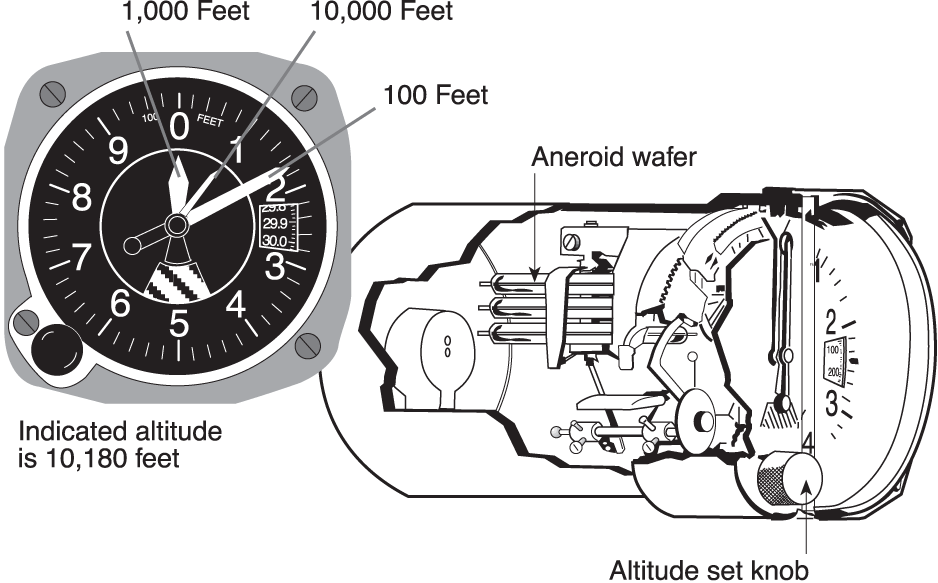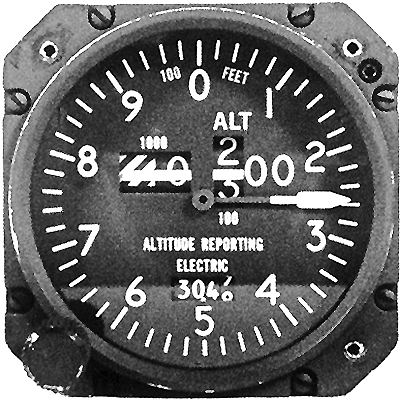Today we’re taking another look at flight instruments, specifically the altimeter. Understanding the instrument and altitudes is critical in learning to fly. This post comes from on of our favorite textbooks, Bob Gardner’s The Complete Private Pilot.
Aircraft altimeters are aneroid (dry) barometers calibrated to read in feet above sea level. The altimeter gets its input from the static port, which is unaffected by the airplane’s movement through the air. An aneroid barometer contains several sealed wafers with a partial internal vacuum, so as the airplane moves vertically and the outside pressure changes, the wafers expand and contract much like an accordion. This expansion and contraction is transmitted through a linkage to the altimeter needles (Figure 1).

Barometers provide a means of weighing the earth’s atmosphere at a specific location. At a flight service station or National Weather Service office, an actual mercury barometer may be used, and on a standard day the weight of the atmosphere will support a column of mercury (Hg) 29.92 inches high at sea level. Inches of mercury are the units of measure for barometric pressure and altimeter settings. The equivalent metric measure is 1013.2 millibars; since our weather is transmitted internationally, the Weather Service uses both inches and millibars in its reports.
Up to 18,000 feet, altitude is measured above sea level, and sea level pressure may vary from 28.50″ to 30.50″ Hg (these are extremes). Your altimeter has an adjustment knob and an altimeter setting window (Figure 1), so that you can enter the sea level barometric pressure (altimeter setting) at your location as received from a nearby flight service station or air traffic control facility. The altimeter will, when properly set, read altitude above mean sea level (msl). As you increase the numbers in the altimeter setting window, the hands on the altimeter also show an increase: each .01 increase in the window is equal to 10 feet of altitude, each .1 is 100 feet, etc.
Above 18,000 feet (and after you get your instrument rating, since all operations above that altitude must be under instrument flight rules), you will set the window to 29.92″ Hg and you will be reading your altitude above the standard datum plane. By international agreement, a standard day at sea level is defined as having a barometric pressure of 29.92 (with the temperature 15°C or 59°F), and by setting your altimeter to 29.92 it will read altitude above that standard level. Below 18,000 feet, having the correct altimeter setting will keep you out of the trees, while above 18,000 feet (where there are no trees or mountains), the common altimeter setting of 29.92 provides altitude separation for IFR flights. There are several altitude terms with which you should be-come familiar:
Indicated altitude is simply what the hands on the altimeter point to. The long hand reads hundreds of feet (the calibrations are 20 feet), the next largest hand reads thousands of feet, and the third indicator reads in tens of thousands. The three-needle altimeter is easily misread, and many new airplanes are being equipped with a drum-pointer altimeter which has only one needle and a counter (Figure 2).

Absolute altitude is your actual height above the surface as read by a radar altimeter.
Pressure altitude is what the hands of the altimeter indicate when the altimeter setting window is set to 29.92″ Hg. You will use pressure altitude in computations of density altitude, true airspeed and true altitude.
Density altitude is a critically important altitude; however, you can’t read it on your altimeter but must calculate it, using pressure altitude and temperature. Density altitude is performance altitude — the airplane and engine perform as though they are at a different altitude than their true altitude.
True altitude is your height above sea level. When you set your altimeter setting window to the local altimeter setting, the altimeter should read field elevation (above sea level). If it doesn’t, record the instrument error. Differences of over 75 feet indicate that the instrument needs overhaul or replacement. (Before you take any drastic steps, be sure that your airplane is not simply located at a point below the published field elevation.) The illustration in Figure 3 shows an airplane with its altitude above the ground (absolute altitude), above sea level (true altitude), and above the standard datum plane of 29.92″ Hg (pressure altitude).

Any obstruction to the static port or static lines will make the altimeter unusable, so some aircraft have alternate static sources vented inside the cockpit. When using the alternate static source, there will be slight errors in the altimeter and airspeed indications. The pressure inside the cockpit is lower than the outside pressure—with the alternate static source selected, the altimeter will read slightly high, the airspeed indicator will read high, and the vertical speed indicator will read correctly after momentarily indicating a climb.




